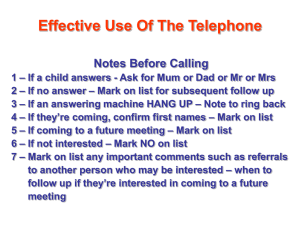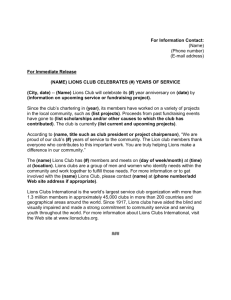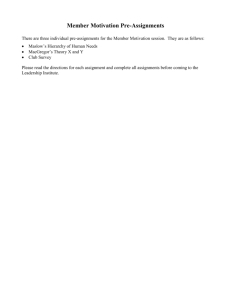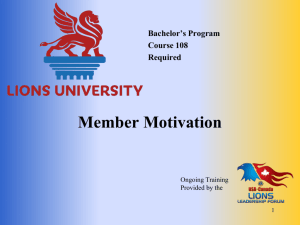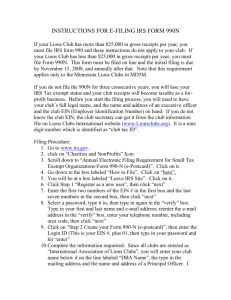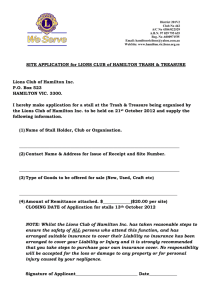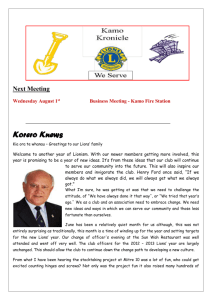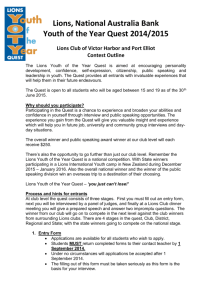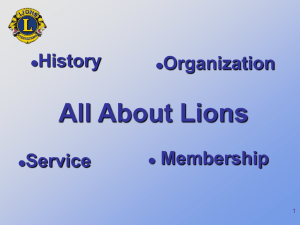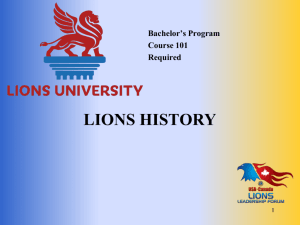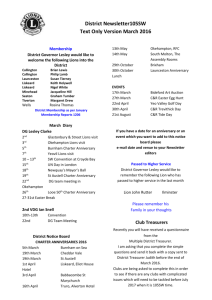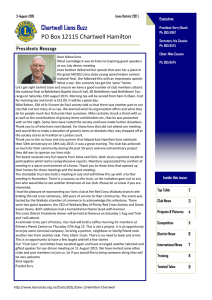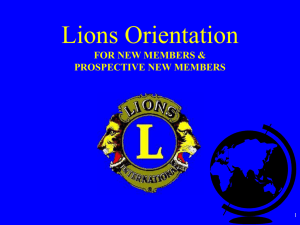Pre-assignment: Need for Effective Training
advertisement
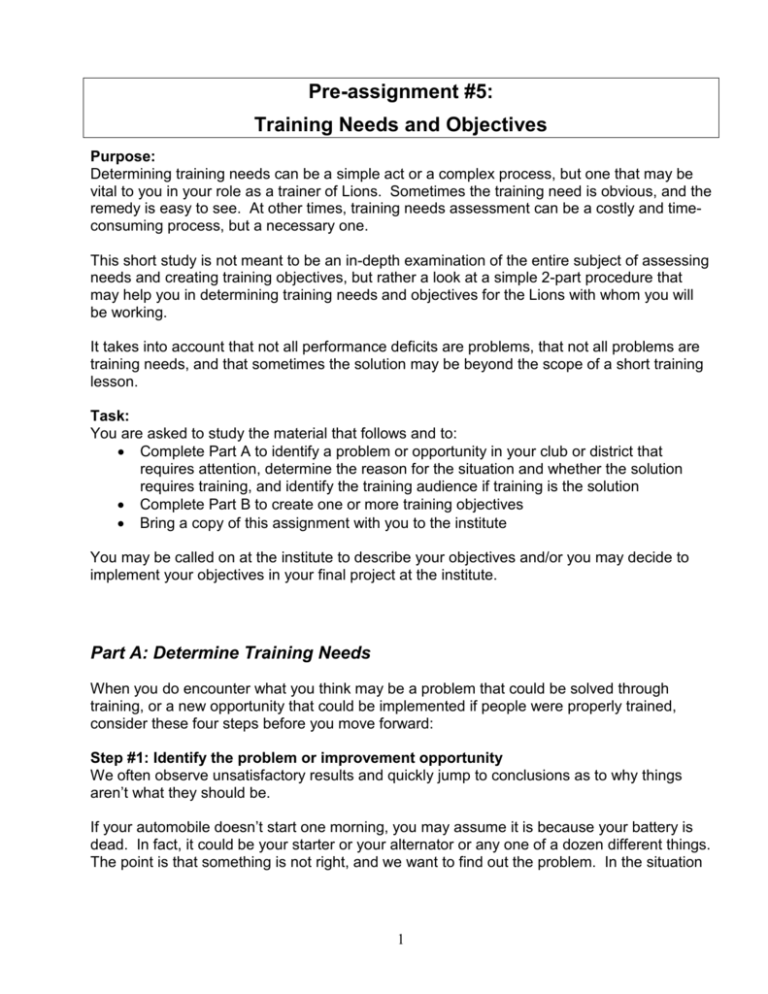
Pre-assignment #5: Training Needs and Objectives Purpose: Determining training needs can be a simple act or a complex process, but one that may be vital to you in your role as a trainer of Lions. Sometimes the training need is obvious, and the remedy is easy to see. At other times, training needs assessment can be a costly and timeconsuming process, but a necessary one. This short study is not meant to be an in-depth examination of the entire subject of assessing needs and creating training objectives, but rather a look at a simple 2-part procedure that may help you in determining training needs and objectives for the Lions with whom you will be working. It takes into account that not all performance deficits are problems, that not all problems are training needs, and that sometimes the solution may be beyond the scope of a short training lesson. Task: You are asked to study the material that follows and to: • Complete Part A to identify a problem or opportunity in your club or district that requires attention, determine the reason for the situation and whether the solution requires training, and identify the training audience if training is the solution • Complete Part B to create one or more training objectives • Bring a copy of this assignment with you to the institute You may be called on at the institute to describe your objectives and/or you may decide to implement your objectives in your final project at the institute. Part A: Determine Training Needs When you do encounter what you think may be a problem that could be solved through training, or a new opportunity that could be implemented if people were properly trained, consider these four steps before you move forward: Step #1: Identify the problem or improvement opportunity We often observe unsatisfactory results and quickly jump to conclusions as to why things aren’t what they should be. If your automobile doesn’t start one morning, you may assume it is because your battery is dead. In fact, it could be your starter or your alternator or any one of a dozen different things. The point is that something is not right, and we want to find out the problem. In the situation 1 of your automobile, you would probably not buy a new battery until you had someone look deeper into the situation to determine what is wrong. Now think about possible problems in your own Lions club. Perhaps your membership is declining in recent years. Your initial thought might be that you have to do a better job of recruiting, but is this the case? Could it be that you are bringing in new members but losing more? Are they leaving because they don’t feel involved or part of the decision-making process in your club…or are they leaving because they are bored with the same projects…or are they leaving because they don’t like to attend your club meetings? All of these are possible, so the first step for you if you are contemplating some manner of training is to identify or “name” the real problem. The simplest way to name the problem is to observe and ask those directly involved. Sometimes you may have to create a questionnaire or some interview questions. Keep in mind that not all training needs are the result of problems. New programs, technology, and initiatives can create new opportunities for Lions to serve. These opportunities may involve new knowledge or skills, so in these cases you are naming the “opportunity” rather than the problem. Use the space below to identify one or more problems (or opportunities) in your club or district that you feel might be best addressed through training. __________________________________________________________________________ Step #2: Analyze the reason After you have identified the problem, you will want to do more detective work to find out why the problem exists. Too often, trainers and course developers make an assumption about the reasons for a problem only to find that they have missed the target completely. If we determined that the problem in the previous step was that members were leaving the club because they did not like attending the meetings, we still need to dig deeper to see what it is about the meetings that do not appeal to them. It could be that they don’t like the restaurant at which the meetings are held, and no amount of training will solve that problem. Or it could be that the meetings are too late in the evening for many of the members. Similarly, training is not the solution. But if you were to discover, by asking or interviewing further, that the reason they did not like attending meetings was that the meetings were too long or were disorganized with little purpose, then you may find that a training session on the skills of effective meeting management can solve the problem. Before deciding that training is the solution to a problem, ask yourself if there is something else about the situation or the environment that surrounds the problem that needs changing. If the answer is “yes,” then training may not be needed or even useful. 2 If you identified a problem in Step #1, explain the reason it exists in the space provided below, and indicate whether you feel training is the solution. (If you identified an opportunity, go directly to Step #3. Step #3: Identify the training audience This may be the easiest step in the process to determine, but it can be a costly mistake to ignore. If you have ever sat through training or attended a seminar and asked yourself, “Why am I here?” you may have been the victim of “mistaken training identity.” When training is the solution to a problem, that training should only be provided to those who can have a direct result on the problem. Training on how to conduct effective meetings is meaningful only to those Lions who may be called on to chair meetings. Rather than provide “blanket” training coverage to large groups, it is more cost-effective and a better use of everyone’s time if you identify only those people who, with the new knowledge or skills, can directly impact the problem or improvement opportunity. If your problem or opportunity requires training, indicate your training audience in the space provided below. (If you find that training is not the solution, go back to Step #1 and try to identify another problem or opportunity.) __________________________________________________________________________ Part B: Create Training Objectives You have named the problem, analyzed the reasons for the problem, and identified those Lions who can have a direct impact on solving the problem. The next important task is to determine specifically what it is they need to be able to do to bridge the gap between what is occurring now and what should be happening. A training objective is an action item that states what the learner will be able to do upon completion of the training. That action is directly related to solving the problem. A typical training session will address one or more objectives. For example, in a session on conducting effective meetings, some training objectives could be: • Prepare meeting agendas • Facilitate group discussions 3 • Manage group behavior Training objectives always start with an action verb. For a training objective to be useful it must be something that can be demonstrated and evaluated. Further, it must be directly related to solving the current problem or achieving the opportunity. In a training session on promoting your club to the public, you might list the following as training objectives: • Create press releases • Conduct interviews However, you would not include: • Complete all LCI reports • Select membership chairperson (These are important tasks, but they are not directly related to promoting your club to the public, so they would not be objectives of your training session.) Use the space below to list one or more specific things your audience will be able to do as a result of your training session. These will be your training objectives. Make sure that you bring a copy of this completed pre-assignment with you to the FDI institute. 4
